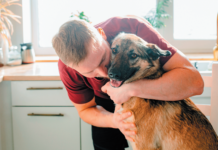Urinating On Purpose Versus Urinary Incontinence
If you see your dog posturing to urinate indoors, it could be a behavioral issue. She may be upset or confused. It could also be a medical issue like a urinary tract infection, diabetes, or Cushing’s disease. Dogs really try to wait until they get outside, but those conditions sometimes increase urgency to the point that they simply can’t wait.
But if urine trickles out without your dog trying to go, perhaps while she is sleeping, it’s likely urinary incontinence. You might find a little puddle at the spot when she wakes up and walks away, or perhaps urine on her rear quarters or her side.
Your Dog Doesn’t Have to Be White to Have Little White Shaker Syndrome
Your dog has always been perfectly fine but now has begun experiencing full-body tremors, or maybe tremors localized to one region, such as the head. Depending on the dog, the tremors range from mild to so severe that they are debilitating and perhaps include loss of balance. In some cases, they are accompanied by nystagmus—back-and-forth or circular eyeball movement that is clearly not in the dog’s control. The tremors tend to increase with exercise, stress, or excitement. What’s going on?
Simple Ways to Know Your Dog’s in Pain
Let’s say “you have a 5-year-old female mixed breed dog who has been happy and healthy since she was a puppy. She has always been very friendly and loved to be petted. Recently she has wanted less interaction with her family and occasionally gets a little snappy when she no longer wants to be petted.”
A genetic component to loving dogs?
Q: My sister and I grew up with dogs, and I absolutely adore them, but she does not. Our parents love animals, especially dogs, and showed us by example how much you can get out of a great relationship with a dog. I should point out that my sister never had a scary experience with an aggressive dog. So why that difference?
Summer Westervelt
Pacific Palisades, California
Upstairs, downstairs
Q: Our 4-year-old hound/shepherd mix has two beds in our house, one upstairs in our bedroom and one downstairs in the living room. Historically, she always spent the day downstairs where we spend most of our own day working from home. She only slept in her bed upstairs at night. Recently, though, she has been choosing to spend more time upstairs during the day—almost all of her inside hours, actually. We have a 1-year-old cat who sometimes steals her downstairs bed, but that has been going on for months and doesn’t account for the new behavior. Should we be concerned?
Carolyn Tilney
Tacoma, Washington
Download The Full December 2024 Issue PDF
- Why “You Know What You Did” is Lost on a Dog
- Short Takes
- How to Engage Your Dog in a New, Fun Activity When You Don’t Have Extra Time to Spare
- Make a Fist…And 5 Other Urban Myths About the Best Way to Approach an Unknown Dog
- Is Tuna Safe for Dogs?
- Improved Disaster Preparedness
- Happy Tail Syndrome
- Dear Doctor
Why “You Know What You Did” is Lost on a Dog
To be vindictive or spiteful takes a certain amount of planning, a sequencing of events in your mind that you then carry out. Dogs simply do not have that ability. They pretty much act in the moment. It’s all about impulse.
If Your Vacuum Doesn’t Have a HEPA Filter
A vacuum with a HEPA filter is one of the best bets for ridding your home of the hair and dander shed by dogs—which for some people causes allergic reactions. HEPA stands for “high efficiency particulate air,” and tightly woven HEPA filters can keep just about all small, inhalable irritants from spewing back into the air as you vacuum—not just dander but also dust and other airborne particles. Make sure filtration efficiency is at least 99.97 percent and that the particles retained are as small as 0.3 micrometers. The label should guide you, and you can also ask the manufacturer.
Don’t Forget to Praise Your Dog for Things He Gets Right!
It’s so easy to yell at a dog to “Put that down!” or “Wait!” Much of the time the yelling is out of fear that the pet will harm himself or cause some kind of trouble. So when the dog complies, there’s relief.
When You Turn Down the Thermostat Before Leaving the House But the Dog Stays...
Dogs, like people, can become uncomfortably cold in winter weather, even if they don’t show it. Thus, if you leave your dog home alone for several hours but turn down the thermostat to save on energy bills, make sure your pet has a fuzzy dog bed with a blanket. If she gets cold enough, she can even pull the blanket over herself with her teeth.
How to Engage Your Dog in a New, Fun Activity When You Don’t Have...
Have you ever invited your dog to walk on a low wall while the two of you were on one of your daily outings together or perhaps make her way along a ramp? If so, then you were having her practice dog parkour. It’s derived from a training program used by military personnel to navigate obstacle courses.
Make a Fist…And 5 Other Urban Myths About the Best Way to Approach an...
“Make a fist.” How often do we hear people tell their preschooler to close their hand into a fist when the youngster wants to pet a dog they don’t know? The belief is that making a fist is less aggressive than going straight to petting and less threatening than an open hand. Also, the thinking goes, making a fist gives the dog an opportunity to get to know the person by sniffing them before there’s any actual body contact.
















